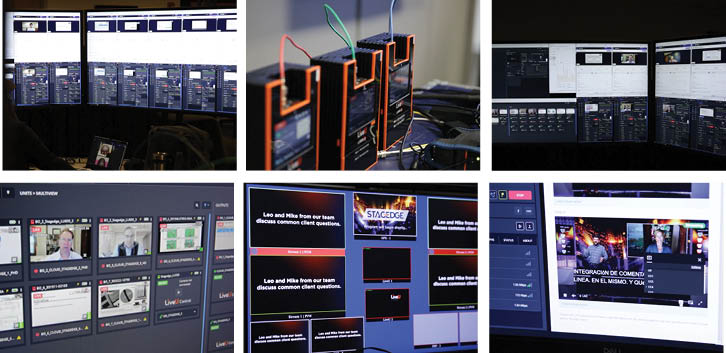A Q&A with Livestream Manager Jim Turner

Once upon a time, events were in-person affairs only. Then livestreaming came along, opening events up to remote audiences in any part of the world. And with the onset of the COVID pandemic, livestream events—and the streaming technology that accompanied them—took off like never before.
What does it take to provide a sophisticated viewing experience for an online audience? What goes on behind the cameras—or on the other side of the screen? We sat down with Stagedge Livestream Manager Jim Turner to learn the ins and outs of hosting a seamless streaming event, and what the future of streaming looks like.
Q: What led you to a career in event production?
JT: I had wanted to get into live events production for a while. The company I was at before did a lot of video production, and at these types of companies, you end up having more than one role—which is good for getting experience. Everybody helps out where it’s needed. At Stagedge, I started as a warehouse manager, then moved into live streaming broadcasts five or six years ago. We were hiring other people to do it for us, and we realized: if clients are asking for it, why don't we do it ourselves? So I volunteered because I was interested in anything broadcast-related, and that's how I got started.

Q: So you started up before the pandemic? And, how did COVID affect things?
JT: Yes, we did. And because we’d gotten on board with event live streaming before COVID, we had the best equipment, we’d invested in the right process—and we were ready to go when it became a necessity during the pandemic. Events could not happen in person, so we converted the entire office into a streaming event space and for about a year, that’s all we did. We would have the Zoom production meeting, take the video feed, isolate each component, and switch it like a live show. Then we would livestream that cut, mixed content.
Now that events have resumed in-person, we’re once again offering a livestream component for in-person events. And for some clients, we'll take on just the livestream part. Dell, for example, hosts a giant expo once a year. They do the production in-house, but we are responsible for streaming it out.
"Because we’d gotten on board with event live streaming before COVID, we had the best equipment, we’d invested in the right process—and we were ready to go when it became a necessity."
Q: What is a typical day like for you?
JT: It depends. Sometimes I'll be on-site as livestream manager with an engineer. For more local events, we'll send the engineer with the equipment truck, and I can monitor remotely from the office. The livestream engineer will hook everything up and then I will do the configuring and control everything remotely.

Q: What work needs to be done pre-and post-event?
JT: First we need to configure the encoders and whichever CDN (website or platform) the client has selected. Then we do our testing leading up to the event to make sure everything is working as it should. And that includes having a proper battery backup and a 4G connection in case the power goes out. Basically, it's the same streaming technology that most news stations use now: they'll send the cameraman out with a backpack with the encoder on instead of the whole crew they used to have. As far as post-event activities, it’s a question of uploading the video and getting a clip of the event for the client’s landing page.
Q: Any tips for clients who want to add a live streaming broadcast? What do they need to know?
JT: In general, clients should prepare as they would for any live event. That is, they should follow the same procedure to prepare for a streaming event as for a live one.
"All the higher-end audiovisual elements you can bring will make your livestream event look that much better. What you put in is what you're going to get out of it."
At the production level, you want to make sure you have the technological elements that are appropriate to a streaming situation. If clients have a larger budget, you are going to want broadcast-level cameras, lighting, and sound. All the higher-end audiovisual elements you can bring will make your livestream event look that much better. What you put in is what you're going to get out of it.
Q: How can audience members watching a livestream event be helped to feel like they're part of it?
JT: The most important thing is making sure they can watch without interruptions. And that means you want as much bandwidth as possible. If you have a lot of people at home on the same network and people are gaming or downloading movies, that could affect the transmission. So, it’s a good idea to get people to reduce their usage—to send guidance out ahead of time.
Once that’s taken care of, there are interactive features you can use, such as questions, comments, and polling, that can make audiences really feel like they’re part of the experience. Live captioning is another one. It's funny: before the pandemic, we would only do live captioning for an event like an outdoor graduation, on the jumbotron, but once the pandemic hit, people wanted captions on everything. And translations, too. We don't do a ton of it, but with one client, we translate into 20 different languages. That's also relatively new since the pandemic.
"The pandemic has made people think about accessibility in ways they hadn't done before—and the new streaming technology that’s coming out will make that all the more possible."
Q: What do you see as the future of streaming?
JT: It’s an interesting field to be in because things are constantly changing: there will always be a new kind of encoder, new products, new event streaming platforms. As I mentioned earlier, the pandemic has made people think about accessibility in ways they hadn't done before—and the new streaming technology that’s coming out will make that all the more possible. So for us, it’s a question of keeping up to date by demoing new things that can streamline the process and make livestream events more efficient. It’s always exciting.

Virtual Events Are Here to Stay
Post-pandemic, audiences expect to have a virtual component to their events—whether real-time streaming or downloadable videos to watch later. At Stagedge, our virtual team has been helping companies host hybrid and virtual events years before the pandemic. Learn more about our virtual offerings by visiting our site or read tips on hosting a hybrid event in our related blog.
This article is also available in a chapter from our latest resource guide:
The Stagedge Events Playbook
You can navigate directly to view more topics or download the Playbook in its entirety for free.
